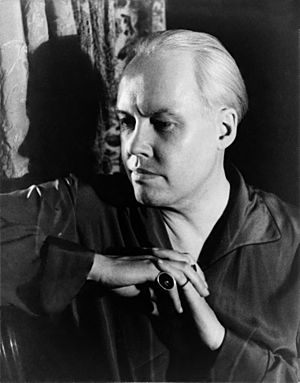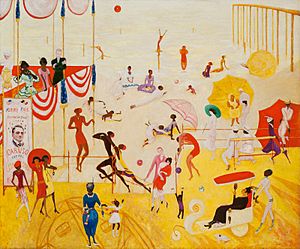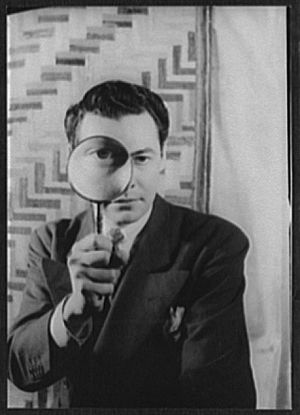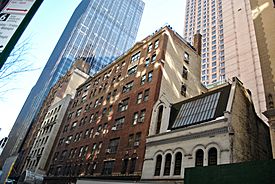Carl Van Vechten facts for kids
Quick facts for kids
Carl Van Vechten
|
|
|---|---|

Self-portrait (1933)
|
|
| Born | June 17, 1880 Cedar Rapids, Iowa, U.S.
|
| Died | December 21, 1964 (aged 84) New York City, U.S.
|
| Education | Washington High School |
| Alma mater | University of Chicago |
| Occupation |
|
| Spouse(s) |
Anna Snyder
(m. 1907–1912) |
Carl Van Vechten (June 17, 1880 – December 21, 1964) was an American writer and photographer. He was a big supporter of the Harlem Renaissance, a time when African-American art and culture thrived. He also managed the writings of famous author Gertrude Stein after she passed away. Carl Van Vechten became well-known for his writing, especially a novel published in 1926. Later in his life, he became a photographer and took many portraits of famous people.
Contents
Early Life and Education
Carl Van Vechten was born in Cedar Rapids, Iowa. He was the youngest child of Charles Duane Van Vechten and Ada Amanda Van Vechten. His parents were both well-educated. His father was a successful banker, and his mother helped start the Cedar Rapids Public Library. She was also very musical.
From a young age, Carl loved music and theater. He finished high school at Washington High School in 1898. After high school, he wanted to explore his interests, but felt his hometown was not the right place. In 1899, he decided to study at the University of Chicago. There, he learned about many subjects, including music, art, and opera. He also became very interested in writing and wrote for the college newspaper.
Starting His Career
After graduating from college in 1903, Carl Van Vechten got a job as a writer for the Chicago American newspaper. He wrote a column called "The Chaperone," where he shared his thoughts and observations on many topics. Sometimes, he was asked to include photos with his column. This was his first experience with photography, which later became a big part of his life.
He left the Chicago American and moved to New York City in 1906. He became an assistant music critic at The New York Times. His love for opera led him to take a break in 1907 to travel to Europe and learn more about it.
New York and New Connections
While in England, Carl Van Vechten married Anna Snyder, a friend from his hometown. He returned to The New York Times in 1909. There, he became the first American critic to write about modern dance. He was greatly influenced by his mentor, Mabel Dodge Luhan, and became very interested in new and experimental art forms.
He often went to exciting new dance performances in New York City. He also attended shows in Paris, where he met the American author and poet Gertrude Stein in 1913. They became close friends, and Carl was one of Stein's biggest fans. They wrote letters to each other for the rest of Stein's life. When she died, she chose him to help publish her writings that had not yet been printed.
Carl Van Vechten wrote an article called "How to Read Gertrude Stein." In it, he tried to make her complex works easier to understand. He believed that special writers like Stein needed special readers who could be guided through her work.
His marriage to Anna Snyder ended in 1912. In 1914, he married actress Fania Marinoff. Carl and Fania were known for welcoming people of all races into their home for social gatherings. This was unusual at a time when society often kept races separate. They also visited their Black friends in their homes and attended public events for Black people.

Carl Van Vechten's marriage to Fania Marinoff lasted for 50 years. He also had a long friendship with Mark Lutz, who was a model for some of Van Vechten's early photographs.
Between 1915 and 1920, Carl Van Vechten published several books of essays about music and literature. He also helped the new publishing company Alfred A. Knopf find new writers. From 1922 to 1930, Knopf published seven novels by him.
Supporting the Harlem Renaissance
Carl Van Vechten loved the arts and was fascinated by the burst of creativity happening in Harlem. He was drawn to the accepting atmosphere in Harlem and the excitement among Black writers and artists. He felt very comfortable there.
He helped promote many important figures of the Harlem Renaissance. These included Paul Robeson, Langston Hughes, Ethel Waters, Richard Wright, Zora Neale Hurston, and Wallace Thurman. In 1926, one of his novels, N***r Heaven, was published. This book caused a lot of discussion. He also wrote an essay called "Negro Blues Singers" for Vanity Fair in 1926. Some historians believe Van Vechten felt that African-American culture was very important to America.
Carl Van Vechten played a key role in the Harlem Renaissance. He helped people better understand the African-American movement. In Harlem, he often went to operas and cabarets. He is credited with increasing white interest in Harlem's nightlife and culture. He also helped talented writers like Langston Hughes and Nella Larsen find publishers for their first books.
In 2001, a collection of letters called "Remember Me to Harlem" was published. These letters showed the long friendship between Van Vechten and Langston Hughes. Another book, Carl Van Vechten and the Harlem Renaissance: A Portrait in Black and White, explored the complex relationship between Black and white people in America during that time.
In the early 1930s, when he was around 50 years old, Carl Van Vechten stopped writing novels. He then started focusing on photography. He used his apartment in New York City as a studio and took many portraits of famous people. He continued to write letters to many friends and colleagues throughout his life.
Carl Van Vechten passed away in 1964 at the age of 84 in New York City. His ashes were scattered in the Shakespeare garden in Central Park.
His Writings
When he was 40, Carl Van Vechten wrote a book called Peter Whiffle. This novel helped him become known as a respected writer. It was seen as an important book for understanding the history of the Harlem Renaissance. In this novel, he used parts of his own life to create a fictional story.
He wrote several other novels, including The Tattooed Countess. This book used his memories of growing up in Cedar Rapids in a disguised way. His book The Tiger in the House explored the interesting habits and qualities of his favorite animal, the cat.
One of his most discussed novels was N***r Heaven. This book received both strong opinions and praise. Carl Van Vechten called it "my Negro novel." He wanted the book to show how African Americans lived in Harlem. He did not want it to focus on the suffering of Black people in the South who faced racism. Many people told him to change the book's title, but he wanted a title that would get attention. His father even wrote to him, saying the title would not be understood and should be changed.
Black readers had different opinions about how the novel showed African Americans. Some felt it made Black people seem "alien and strange." Others valued the book because it showed African Americans as everyday people with complex lives, just like white characters. Supporters of the novel included Nella Larsen, Langston Hughes, and Gertrude Stein. They all defended the book for bringing Harlem society and racial issues to the attention of America.
Well-known critics of this novel included African-American scholar W. E. B. Du Bois and novelist Wallace Thurman. Du Bois called the novel "cheap melodrama." Years later, writer Ralph Ellison said Van Vechten was a bad influence. Historian David Levering Lewis called N***r Heaven a "colossal fraud" in 1981. He felt that any positive message in the book was overshadowed by its portrayal of Harlem nightlife.
List of Works
- Music After the Great War (1915)
- Music and Bad Manners (1916)
- Interpreters and Interpretations (1917)
- The Merry-Go-Round (1918)
- The Music of Spain (1918)
- In the Garret (1919)
- The Tiger in the House (1920)
- Lords of the Housetops (1921)
- Peter Whiffle (1922)
- The Blind Bow-Boy (1923)
- The Tattooed Countess (1924)
- Red (1925)
- Firecrackers. A Realistic Novel (1925)
- Excavations (1926)
- N***r Heaven (1926)
- Spider Boy (1928)
- Parties (1930)
- Feathers (1930)
- Sacred and Profane Memories (1932)
Published After His Death
- The Dance Writings of Carl Van Vechten (1974)
Collections of His Work
Most of Carl Van Vechten's personal papers are kept at the Beinecke Rare Book & Manuscript Library at Yale University. This library also has a collection called "Living Portraits: Carl Van Vechten's Color Photographs of African Americans, 1939–1964." This collection includes 1,884 color slides.

The Library of Congress has about 1,400 of his photographs. There are also collections of his photos at the Smithsonian's Archives of American Art, Fisk University, and the Museum of the City of New York. Brandeis University also holds many of his portraits. Carl Van Vechten also gave materials to Fisk University to create the George Gershwin Memorial Collection of Music.
The Philadelphia Museum of Art has one of the largest collections of Van Vechten's photographs in the United States. This collection started in 1949 when he donated sixty of his photos. In 1965, Mark Lutz gave the museum over 12,000 photographs from his personal collection. These photos include portraits of many figures from the Harlem Renaissance, like Langston Hughes, Ella Fitzgerald, Billie Holiday, Zora Neale Hurston, and Cab Calloway. He also photographed artists like Marcel Duchamp, Henri Matisse, Joan Miró, and Frida Kahlo, along with many other actors and musicians. The collection also has photos he took at the 1939 New York World's Fair and during his travels in Europe and North Africa in 1935–1936.
In 1980, a photographer named Richard Benson helped save 50 of Van Vechten's portraits. These photos were printed using a special technique called gravure prints. The album, called 'O, Write My Name': American Portraits, Harlem Heroes was finished in 1983. These special prints are now part of the permanent collection at the Smithsonian American Art Museum.
The National Portrait Gallery in London has 17 of Van Vechten's portraits of important creative people from his time. More than 3,000 of his portraits are available on Wikimedia Commons. Many of his public domain photographs are used to illustrate Wikipedia articles about famous Americans from the mid-20th century.
Images for kids
-
Peter Abrahams, 1955
-
Marian Anderson, 1940
-
Antony Armstrong-Jones, 1958
-
Christopher Isherwood and W. H. Auden, 1939
-
Pierre Balmain and Ruth Ford, 1947
-
Tallulah Bankhead, 1934
-
James Baldwin, 1955
-
Harry Belafonte, 1954
-
Karen von Blixen-Finecke, 1959
-
Clare Boothe Luce, 1932
-
Marlon Brando, 1948
-
Truman Capote, 1948
-
Katharine Cornell, 1933
-
Giorgio de Chirico, 1936
-
Salvador Dalí, 1934
-
Gloria Davy, 1958
-
Ruby Dee, 1962
-
John Gielgud as Richard II, 1936
-
William Faulkner, 1954
-
F. Scott Fitzgerald, 1937
-
Lynn Fontanne, 1932
-
Ben Gazzara, 1955
-
Dizzy Gillespie, 1955
-
Martha Graham and Bertram Ross, 1961
-
W. C. Handy, 1941
-
Julie Harris, 1952
-
Billie Holiday, 1949
-
Nora Holt, 1955
-
Lena Horne, 1941
-
Marilyn Horne and Henry Lewis, 1961
-
Zora Neale Hurston, 1938
-
José Iturbi, 1933
-
Mahalia Jackson, 1962
-
Philip Johnson, 1933
-
Eartha Kitt, 1952
-
Fernand Léger, 1936
-
Canada Lee, 1941
-
Lotte Lenya, 1962
-
Joe Louis, 1941
-
Alfred Lunt, 1932
-
Norman Mailer, 1948
-
Henri Matisse, 1933
-
Somerset Maugham, 1934
-
Elsa Maxwell, 1935
-
Gian Carlo Menotti, 1944
-
Francisco Moncion, 1947
-
Robert Morse, 1958
-
Laurence Olivier, 1939
-
Christopher Plummer, 1959
-
Luise Rainer, 1937
-
Cesar Romero, 1934
-
Walter Slezak, 1934
-
Bessie Smith, 1936
-
Gertrude Stein, 1935
-
James Stewart, 1934
-
William Grant Still, 1949
-
Paul Taylor, 1960
-
Virgil Thomson, 1947
-
Antony Tudor, 1941
-
Gore Vidal, 1948
-
Hugh Walpole, 1934
-
Ethel Waters, 1938
-
Evelyn Waugh, 1940
-
Orson Welles, 1937
-
Anna May Wong, 1939
See also
 In Spanish: Carl van Vechten para niños
In Spanish: Carl van Vechten para niños



















































































